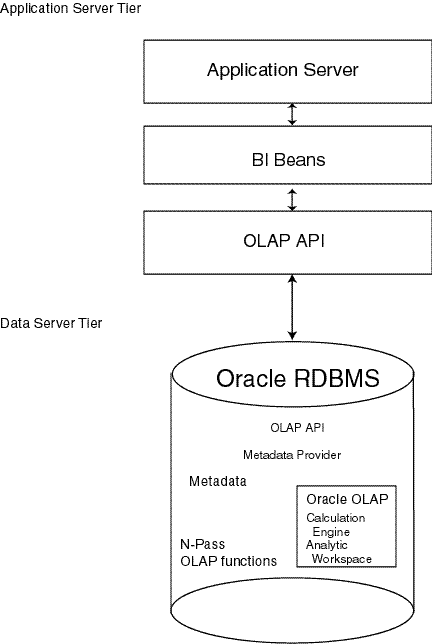| Oracle9i OLAP User's Guide Release 2 (9.2.0.2) Part Number A95295-02 |
|
|
View PDF |
| Oracle9i OLAP User's Guide Release 2 (9.2.0.2) Part Number A95295-02 |
|
|
View PDF |
The BI Beans provide reusable components that are the basic building blocks for OLAP decision support applications. Using the BI Beans, developers can rapidly develop and deploy new applications, because these large functional units have already been developed and tested -- not only for their robustness, but also for their ease of use. And because the BI Beans provide a common look and feel to OLAP applications, the learning curve for end users is greatly reduced.
Two groups of BI Beans are currently available:
The Presentation Beans can be implemented as a thick client or a thin client. Thick clients best support users who do immersed analyses, that is, use the system for extensive periods of time with a lot of interaction. For example, users who create reports benefit from a thick client. Thin clients best support remote users who use a low bandwidth connection and have basic analytical needs. Thin clients can be embedded in a portal or other Web site for these users.
You can use the BI Beans in either thick-client or thin-client applications.
| See Also:
For more information about the BI Beans, go to the Oracle Web site at |
The components of an OLAP thick-client application are grouped into three tiers, which can be on separate platforms or the same platform:
Figure 3-2 shows these relationships in a thick-client configuration.

Text description of the illustration thickcli.gif
The components of an OLAP thin-client application are grouped into two tiers, which can be on separate platforms or the same platform:
Figure 3-3 shows these relationships in a thin-client configuration.

Text description of the illustration thinclie.gif
The OLAP API and the BI Beans use the OLAP Catalog to provide the information they need about multidimensional objects defined in an Oracle data warehouse, such as measures and dimensions. For information about metadata and other requirements, refer to Chapter 4, "Designing Your Database for OLAP".
The BI Beans employ a runtime repository in the Oracle database that allows users to save their personal analyses and to share their discoveries with other users.
The Presentation BI Beans support navigation techniques such as drilling, pivoting, and paging.
The Presentation BI Beans allow you to change the appearance of a particular display. In addition, the values of the data itself can affect the format.
The Graph bean presents data in a large selection of two- and three-dimensional business chart types, such as bar, area, line, pie, ring, scatter, bubble, pyramid, and stock market. Many of the 2D graphs can be displayed as clustered, stacked, dual-Y, percentage, horizontal, vertical, or 3D effect.
Bar, line, and area graphs can be combined so that individual rows in the data cube can be specified as one of these graph types. You can also assign marker shape and type, data line type, color, and width, and fill colors on a row-by-row basis.
The graph image can be copied to the system clipboard and exported in GIF and other image formats.
Users can zoom in and out of selected areas of a graph. They can also scroll across the axes.
The Crosstab bean presents data in a two-dimensional grid similar to a spreadsheet. Multiple dimensions can be nested along the rows or columns, and additional dimensions can appear as separate pages. Among the available customizations are: Font style, size, color and underlining; individual cell background colors; border formats; and text alignment.
Users can navigate through the data using either a mouse or the keyboard. They can insert rows and columns to display totals, and edit cells for what-if analysis.
The Table bean presents data in record format like a relational table or view. In contrast to the crosstab, the table display handles measures individually rather than as members of a measure dimension. Thus, each measure can be manipulated individually.
The OLAP BI Beans use the OLAP API to provide the basic services needed by an application. They enable clients to identify a database, present credentials for accessing that database, and make a connection. The application can then access the metadata and identify the available data. Users can select the measures they want to see and the specific slice of data that is of interest to them. That data can then be modified and manipulated.
The BI Beans offer wizards that can be used both by application developers in creating an initial environment and by end users in customizing applications to suit their particular needs. The wizards lead you step-by-step so that you provide all of the information needed by an application. The following are some of the tasks that can be done using wizards.
The BI Beans take advantage of all of the new OLAP functions in the database, including ranking, lag, lead, and windowing. End users can create powerful queries that ask sophisticated analytical questions, without knowing SQL at all.